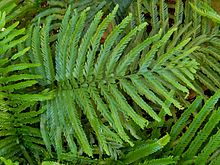Asplenium surrogatum is a species of fern in the family Aspleniaceae.[1][2] It is endemic to Australia's subtropical Lord Howe Island in the Tasman Sea. It grows both terrestrially and as an epiphyte. It occurs in forest at high elevations on the island's mountains.[3]
| Asplenium surrogatum | |
|---|---|

| |
| Scientific classification | |
| Kingdom: | Plantae |
| Clade: | Tracheophytes |
| Division: | Polypodiophyta |
| Class: | Polypodiopsida |
| Order: | Polypodiales |
| Suborder: | Aspleniineae |
| Family: | Aspleniaceae |
| Genus: | Asplenium |
| Species: | A. surrogatum
|
| Binomial name | |
| Asplenium surrogatum | |
| Synonyms[1] | |
| |
Taxonomy
editA global phylogeny of Asplenium published in 2020 divided the genus into eleven clades,[4] which were given informal names pending further taxonomic study. A. surrogatum belongs to the "Neottopteris clade",[5] members of which generally have somewhat leathery leaf tissue. It forms a clade with A. milnei and A. pteridoides, two other Lord Howe Island endemics, suggesting that all three species diverged after a single colonization of the island by their ancestor.[6] This clade is sister to a large group of Pacific Ocean spleenworts.[5]
References
edit- ^ a b "Asplenium surrogatum P.S.Green". Plants of the World Online. The Trustees of the Royal Botanic Gardens, Kew. n.d. Retrieved April 28, 2024.
- ^ "Asplenium surrogatum P.S.Green". Catalogue of Life. Species 2000. n.d. Retrieved April 28, 2024.
- ^ Brown, E.A. "Asplenium surrogatum P.S.Green". PlantNET: New South Wales Flora Online. National Herbarium of NSW: Sydney. Retrieved 2014-01-23.
- ^ Xu et al. 2020, p. 27.
- ^ a b Xu et al. 2020, p. 31.
- ^ Xu et al. 2020, p. 41.
- Xu, Ke-Wang; Zhang, Liang; Rothfels, Carl J.; Smith, Alan R.; Viane, Ronald; Lorence, David; Wood, Kenneth R.; Cheng, Cheng-Wei; Knapp, Ralf; Zhou, Lin; Lu, Ngan Thi; Zhou, Xin-Mao; Wei, Hong-Jin; Fan, Qiang; Chen, Su-Fang; Cicuzza, Daniele; Gao, Xin-Fen; Li, Wen-Bo; Zhang, Li-Bing (2020). "A global plastid phylogeny of the fern genus Asplenium (Aspleniaceae)". Cladistics. 36 (1): 22–71. doi:10.1111/cla.12384. PMID 34618950. S2CID 201197385.